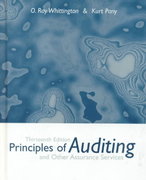Select the best answer for each of the following and explain fully the reason for your selection.
Question:
Select the best answer for each of the following and explain fully the reason for your selection.
a. Instead of taking a physical inventory count on the balance sheet date the client may take physical counts prior to the year-end if internal control is adequate and:
(1) Computerized records of perpetual inventory are maintained.
(2) Inventory is slow-moving.
(3) Computer error reports are generated for missing prenumbered inventory tickets.
(4) Obsolete inventory items are segregated and excluded.
b. The auditor's analytical procedures will be facilitated if the client:
(1) Uses a standard cost system that produces variance reports.
(2) Segregates obsolete inventory before the physical inventory count.
(3) Corrects material weaknesses in internal control before the beginning of the audit.
(4) Reduces inventory balances to the lower of cost or market.
c. When perpetual inventory records are maintained in quantities and in dollars and internal control over inventory is weak, the auditor would probably:
(1) Want the client to schedule the physical inventory count at the end of the year.
(2) Insist that the client perform physical counts of inventory items several times during the year.
(3) Increase the extent of tests for unrecorded liabilities at the end of the year.
(4) Have to disclaim an opinion on the income statement for that year.
d. Which of the following is the best audit procedure for the discovery of damaged merchandise in a client's ending inventory?
(1) Compare the physical quantities of slow-moving items with corresponding quantities of the prior year.
(2) Observe merchandise and raw materials during the client's physical inventory taking.
(3) Review the management's inventory representations letter for accuracy.
(4) Test overall fairness of inventory values by comparing the company's turnover ratio with the industry average.
e. McPherson Corp. does not make an annual physical count of year-end inventories, but instead makes weekly test counts on the basis of a statistical plan. During the year, Sara Mullins, CPA, observes such counts as she deems necessary and is able to satisfy herself as to the reliability of the client's procedures. In reporting on the results of her examination, Mullins:
(1) Can issue an unqualified opinion without disclosing that she did not observe year-end inventories.
(2) Must comment in the scope paragraph as to her inability to observe year-end inventories, but can nevertheless issue an unqualified opinion.
(3) Is required, if the inventories were material, to disclaim an opinion on the financial statements taken as a whole.
(4) Must, if the inventories were material, qualify her opinion.
f. The primary objective of a CPA's observation of a client's physical inventory count is to:
(1) Discover whether a client has counted a particular inventory item or group of items.
(2) Obtain direct knowledge that the inventory exists and has been properly counted.
(3) Provide an appraisal of the quality of the merchandise on hand on the day of the physical count.
(4) Allow the auditor to supervise the conduct of the count so as to obtain assurance that inventory quantities are reasonably accurate.
Step by Step Answer:

Principles Of Auditing And Other Assurance Services
ISBN: 9780072327267
13th Edition
Authors: Ray Whittington, Kurt Pany





